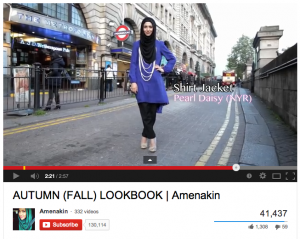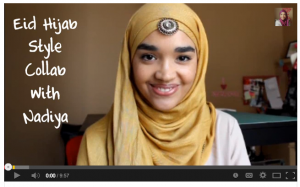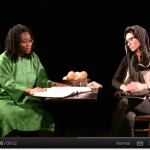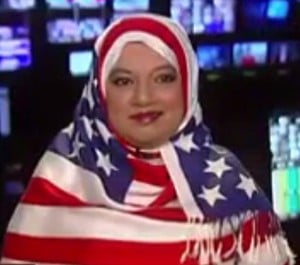This post was written by guest contributor Kristin Peterson (@KrissyPetey), who also blogs at Third Spaces, a group blog for researchers at CU-Boulder’s Centre for Media, Religion and Culture.
YouTube is frequently the go-to place to check out the latest hilarious video, view a clip from a movie, or watch a music video. Over the last few years, YouTube has also become a space where young people can create and post videos, sharing their personalities and advice on various topics, while also attracting more and more “likes” and followers. A popular genre of these amateur-style videos is the female lifestyle video, which features topics like fashion styles, makeup tutorials, beauty product recommendations, relationship advice, and dieting tips. In many ways, these highly polished and entertaining videos have replaced the female fashion magazine. For example, one of the most popular individuals on YouTube is Michelle Phan, a self-described “makeup guru” who attracts millions of viewers to each of her videos and was recently featured in an advertisement for Dr. Pepper. These lifestyle videos are not only entertaining for viewers, but they are also highly lucrative for the video-makers who can attract larger followings.

YouTube is also full of numerous videos that share information about Islam, and along with the many YouTube videos about Islamic theology and scholarship, there is also a community of young women who post videos about lifestyle advice and daily activities, like how to wear hijab, recipes for holiday meals, and makeup tips. While many of these videos are meant to be entertaining and frequently imitate popular video forms on YouTube, the videos still incorporate strong Islamic themes and sensibilities.
YouTube is a flexible medium that allows for these Muslim women to blend together elements of popular culture with their Islamic faith. Young Muslimahs living in North America and Europe are frequently fighting against an assumed dichotomy that they must either assert their Islamic identity or assimilate into Western culture. For young Muslimahs who have grown up in places like the U.S., Canada, or the U.K., this dichotomy usually does not speak to their personal experiences. While these Muslimah lifestyle videos may come as a surprise to those not familiar with Islam, this hybrid style of modest fashion videos or halal makeup tutorials is not out of the ordinary for these women. These videos are just another example of how Muslimahs are using online media forms to make meaning in their lives and to express themselves.
With the larger trends of mainstream lifestyle videos in mind, several Muslimahs have created YouTube channels that feature similar lifestyle videos while incorporating Islamic styles and values. For example, a popular trend on YouTube is the Outfit of the Day (OOTD) video, in which women discuss what they are wearing that day and from where the items were purchased (check out examples of mainstream OOTD videos here and here). Several Muslim YouTubers (saimastyleslike, TheSewist, dinatokio) have posted similar videos, but they feature outfits that are seen as more modest (long skirt or pants covered by a tunic, long-sleeved shirt, and a headscarf), and the outfits are frequently being worn to go to religious celebrations. These videos focus on common lifestyle topics (fashion, makeup, relationships, nutrition), but they incorporate Islamic elements to distinguish them from the mainstream videos and to always keep Islamic values at the center of their lives. For example, the women discuss how to dress and act piously, apply simple and natural makeup, offer nutritional tips for fasting during Ramadan, and use Islamic phrases and prayers in their videos. In addition, not all the videos on these sites are about lifestyle topics. Several video-makers (Nye Armstrong and ChelseyHijabLove) are also converts to Islam and have filmed videos about their personal experiences as converts, as well as useful tips for new Muslims.

Another popular “tag video” on YouTube is the “My Boyfriend/Husband Does my Makeup” tag in which the boyfriend/husband of one of the YouTube celebrities, such as Michelle Phan or Jenna Marbles, applies makeup to the face of his girlfriend on camera. The male partner gets to select the colors and types of makeup to use, and usually the end result is that the female’s face looks somewhat like a clown’s face. Several Muslimahs on YouTube have also created similar tag videos, but have added an Islamic twist. Amenakin posted a video where her husband does her hijab for her instead of her makeup. The Sewist also posted a video where her two young daughters apply makeup to her face. While both of these videos are fun and light-hearted, the videos also illustrate the personalities of the video-makers and their relationships with family members.
One of the most popular Muslim women on YouTube is Amena or “Amenakin,” a British woman who started her video channel four years ago with her first hijab tutorial. Amena founded a hijab fashion company, Pearl Daisy, and created her own style of a headscarf, called a hoojab; viewers can purchase a hoojab online and then watch one of Amena’s videos to learn how to wear it. Amena was instrumental in starting this movement of young Muslimahs on YouTube, and several video-makers cite her videos as inspiration to create their own videos. Amena’s videos feature similar topics as the other lifestyle videos on YouTube, but she also incorporates “Islamic” themes, such as gender interactions, marriage issues, stereotypes about Islam, Islamic identity, and the reasons for wearing hijab.
In one specific video, entitled “We are More than What We Wear,” Amena discusses how Muslim women should not be judged by what type of hijab they wear, or if they don’t wear hijab. Amena discusses meeting women in public who are often self-conscious that their hijab is not as trendy as Amena’s. She addresses these women in the video: “Sisters, trust me, I don’t notice your hijab styles or your hijabs. And I mean this in the nicest way. What comes across above all of the exterior is you as a person.” She encourages her followers to focus on wearing the hijab for God and not because of peer pressure, and she explains that wearing the headscarf is just one part of living as a Muslim. She emphasizes that interior character is more important than exterior appearance. She says, “Let your soul shine through, not your hijab style or your hijab color or how trendy or fashionable you are.”
Amena’s video is addressing a legitimate critique (voiced in another Muslimah Media Watch blog post by Izzie) that these hijab and makeup tutorials are setting a very high standard for what constitutes beauty. At first glance, Amena’s channel appears to be promoting this neoliberal view that the best Muslim women are the ones who can buy headscarves and makeup to become the most fashionable. Contrary to this, Amena says in this video that she doesn’t support the assumption that women can “buy empowerment” by purchasing material things. She says that humans have larger concerns. “The only thing that can empower you is the state of your own soul, and the relationship that you have with Allah.” Amena has talked very poignantly in other videos (here and here) about the reasons why she wears the hijab, which come out of a deep commitment to her faith.
On the other hand, it’s hard to argue that Amena’s channel is all about promoting the religious aspects of wearing hijab when most of her videos are hijab tutorials that focus on superficial aspects of the hijab. In addition, when Amena does post a video that is about a more significant Islamic issue, several of the comments on the videos are from viewers who don’t care about the issue in the video but want to know how she tied her headscarf or where they can buy that headscarf. While Amena’s videos do tackle deeper Islamic issues, the fact remains that she has become very popular not for her issue videos but for her hijab tutorials and fashion style videos. Amena’s channel illustrates the real pressures that many Muslimahs face to dress modestly in order to follow their faith but to also be fashionable and beautiful. These pressures frequently come from within the Islamic community, but there are also larger social pressures that all women face to be attractive, fashionable and skinny. Amena addresses these pressures in some of her videos, but perhaps she does not go far enough to challenge the idea that Muslimahs need to appear in a particular way.
Whether the viewers agree or disagree with what Amena says in her videos, YouTube (like the Muslimah Media Watch blog) still provides a space for Muslimahs to discuss and debate these issues and concerns. On a lighter note, YouTube also is a space where Muslims can be creative and post funny and entertaining videos. On her two YouTube channels (here and here), Nye Armstrong has posted videos about numerous topics like advice for converts, practical information about Islam, her experiences as a convert, travel vlogs, and product recommendations. In one of her most popular videos, Nye shares a unique hijab tutorial in which she explains how to tie your hijab to resemble Princess Leia’s hair buns from the Star Wars films. Nye uses a brown scarf and pins to create the look, and after the buns are complete she jokes around on camera by swinging her light saber back and forth and quoting lines from an episode of 30 Rock, which referenced Princess Leia. This video recently attracted the attention of BuzzFeed and Huffington Post, in which the title of the BuzzFeed article refers to Nye as an “awesome girl” and the Huffington Post headline reads, “Princess Leia Hijab Tutorial Gives Traditional Garb a Quirky Spin.” Despite the problematic assumptions about Islam in these articles, this video is another example of how Muslimahs on YouTube are blending their faith with popular culture and contemporary styles.
Although the mainstream media may continue to promote the dichotomy of Western culture versus Islam, YouTube and other social media sites are spaces that allow for a hybridity of styles and a combination of different issues that reflect the life experiences of Muslim women living in the Western context. Muslimahs post lifestyle videos on various topics onto YouTube as a way to express their experiences and to challenge the assumptions about Muslim women. Young Muslimahs are comfortable in this in-between space of YouTube because this reflects their daily experiences: active online and involved in consumer culture, but still wanting to maintain their faith and pious values.














